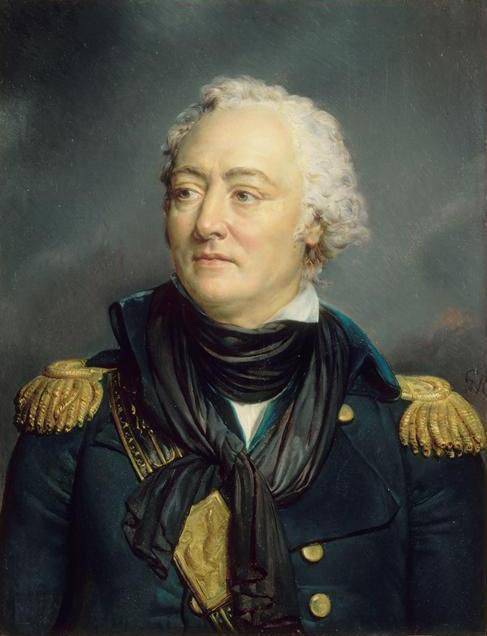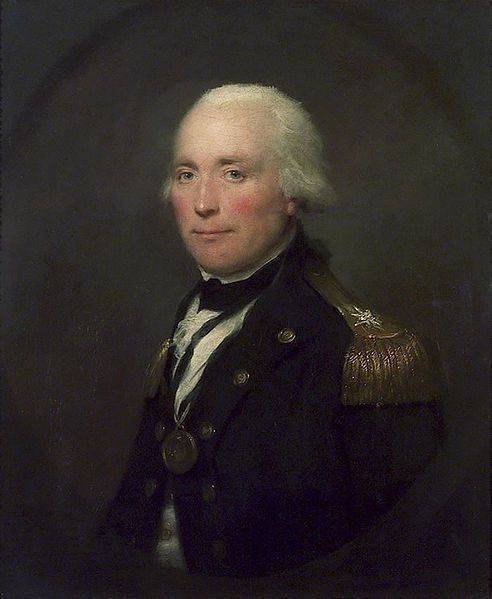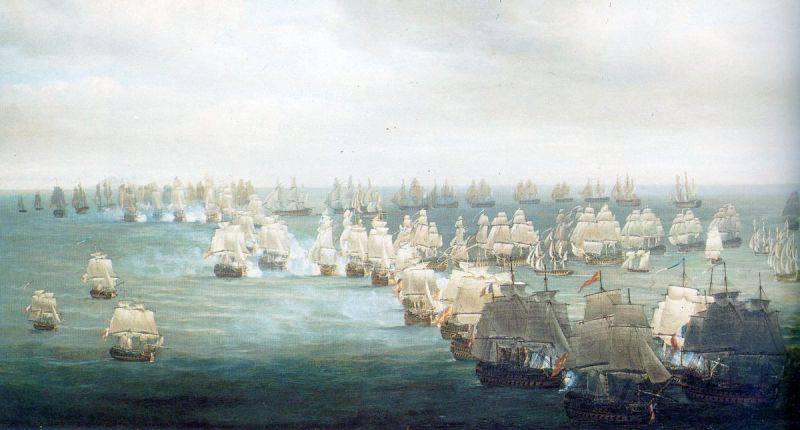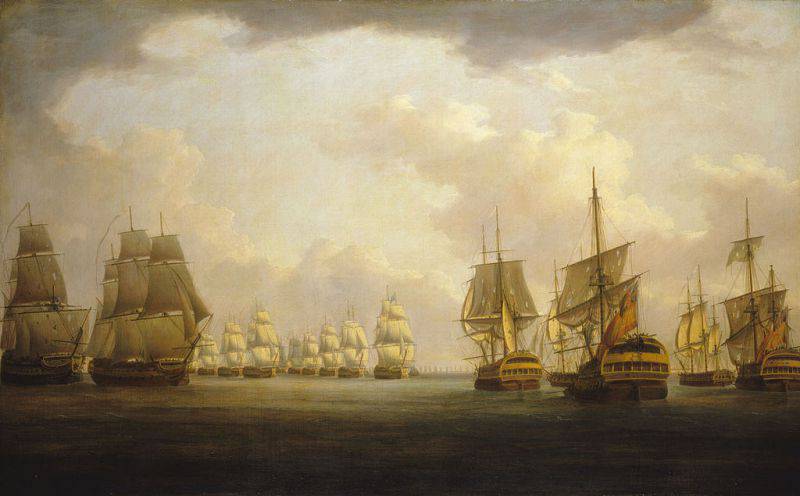How England became the "mistress of the seas"
210 years ago, on October 21, 1805, the Battle of Trafalgar took place - the decisive battle between the English fleet under the command of Vice Admiral Horatio Nelson and the Franco-Spanish fleet of Admiral Pierre Charles Villeneuve. The battle ended in the complete defeat of the Franco-Spanish fleet, which lost twenty-two ships, while the British fleet - not a single one.
The Battle of Trafalgar was part of the War of the Third Coalition and the most famous maritime confrontation of the 19th century. This naval battle had strategic implications. The decisive victory of the British fleet confirmed Britain’s sea supremacy. The Anglo-French rivalry on the sea was a red thread through the whole XVIII century. The maritime confrontation, which began as a battle between England and Spain, and England with Holland, and then England with France (with the support of Spain), ended with a convincing British victory. England for a long time won the status of "Mistress of the seas." Napoleon, despite convincing victories on land, had to postpone the plan of the landing operation in England.
At the same time, the assertions of some Western scholars that the Battle of Trafalgar was decisive in defeating the French empire have no basis. The outcome of the confrontation with Napoleon was decided on land. And only Russian bayonets crushed Napoleon's empire. In the field of tactics, Admiral Nelson successfully applied the recommendations of the English military theorist J. Clerk and the combat experience of the Russian fleet, including Admiral F. F. Ushakov. Nelson resolutely abandoned the dogmas of linear tactics that prevailed in the 18th century. and which adhered to his opponent. Previously, the Russian admiral Ushakov won in the same way.
The battle became tragic for fleet commanders. Admiral Nelson, who personified the recent successes of the British fleet, was mortally wounded by a musket bullet in this battle and died, having received the report of England’s complete victory before his death. The French admiral Pierre-Charles de Villeneuve was captured. He was in England as a prisoner of war until April 1806. He was released on parole that he would no longer fight against Britain. Being completely demoralized due to the disruption of the expedition to England and the loss of the fleet, 22 on April 1806 committed suicide (according to another version, he was stabbed to death). The brave Spanish admiral Federico Gravina, who in this battle, he lost a hand shattered with a canister, could not recover from the wound and died on March 9 of the year 1806.

French admiral Pierre-Charles de Villeneuve
prehistory
Trafalgar became a landmark event that, together with Waterloo, ended a lengthy Anglo-French conflict, which was called the “Second Hundred Years War”. There was a “cold war” between the two great powers, which at times turned into a “hot war” - the wars of the Augsburg League, for the Spanish and Austrian legacies. Seven, for the independence of the British North American colonies. London and Paris competed in everything - from trade and colonies to science and philosophy. During this period, Britain formulated a key principle of foreign policy - the struggle against the strongest continental power, as having the greatest potential for harming British interests. As a result, by the end of the 18th century, France had lost most of its first colonial empire (the second was created already in the 19th century). French trade gave way to the British, the French fleet could no longer challenge the British.
A new war between England and France began after the dissolution of London's Amiens peace in May 1803. Napoleon began planning an invasion of England. England broke a new anti-French coalition, the main striking force of which was Austria and Russia.
Standoff at sea
By the beginning of the new war, in 1803, the position of England at sea was, on the whole, excellent. During the previous war, British military power increased many times: in the eight years of war, the fleet of England increased from 135 battleships and 133 frigates to 202 and 277, respectively. At the same time, the French fleet was greatly weakened: the number of battleships and frigates of ships decreased from 80 and 66 to 39 and 35. After naval victories at Cape San Vicente, at Camperdown in 1797, and Aboukir in 1798, when the Spanish, Dutch and French fleets were defeated, the Copenhagen battle of 1801, which ended in the destruction and capture of the Danish fleet, was confident in Britain of victory on the sea. London was disturbed only by the plan for the landing of the landing army in England. Given the practical absence of full-fledged ground forces in England, and the excellent fighting qualities of Napoleon’s troops, such an operation undoubtedly led to the British military catastrophe.
Therefore, the British command attached great importance to the blockade of the Franco-Spanish naval forces. The largest of the French squadrons were located in Brest (18 of the battleships and 6 frigates), Toulon (respectively 10 and 4), Rochefort (4 and 5), Ferrol (5 and 2). Each French port was blocked by superior British forces: battleships 20 and 5 frigates for Brest, 14 and 11 for Toulon, 5 and 1 for Rochefort, 7 and 2 for Ferrol. Additional British squadrons were deployed in the Channel and approaches to it - in total in both straits of the 8 battleships and 18 frigates. The Dutch fleet was guarding the 9 British battleships and 7 frigates. The approaches to Ireland were guarded by several frigates.
Thus, the British had a significant superiority in naval forces. In addition, they occupied an advantageous position, being relatively close to their ports and bases, all their communications were free. It is also worth noting that during this period the French fleet was greatly degraded and the previous balance between the English and French fleets, which had previously cost one another, disappeared. France, due to internal unrest, launched its fleet heavily. Emigration deprived the French fleet of most of the old officers, the fleet was poorly organized, supplied on a residual basis (in the first place was the army, which solved the problem of the survival of France). Ships prepared for battles hastily, the crews were weak, heterogeneous, recruited from everywhere to replace those that had left.
As a result, the French needed to bring their strongest squadrons together, each time avoiding a dangerous battle with superior British blocking squadrons, bring them to the Canal and wait there for an opportune moment for a throw to England. The task of the British was simpler: to maintain the blockade, if possible to destroy enemy ships. However, we had to take into account the factor of weather conditions. Sailing ships depended on the wind, and the weather could have prevented the French from leaving the harbor and vice versa, allowing the blockaded squadron to slip, for example, from Brest, while the British ships could remain in a calm zone.
Plans for the French command. The actions of the French fleet
The French command needed to solve a difficult task. Originally it was planned that the Toulon squadron, taking advantage of favorable weather, would break the blockade and detach itself from the British squadron under the command of Nelson, which was based on the La Maddalena islands in Bonifacio Strait between Sardinia and Corsica. Then the Toulon squadron had to break through Gibraltar and follow the situation to Ferrol (naval base and port on the northern coast of Spain), and better - to Rochefort (French port on the Atlantic coast). The squadron in Brest was supposed to show activity in order to divert the British. The French squadron, formed from forces based in Toulon and Rochefort, was to move north, not through the Canal, but around Ireland, demonstrating the intention to land troops on this island and raise a revolt of the local population oppressed by the British. Only then, without entering the Irish Sea, the French fleet had to go around England itself and reach Boulogne from the north. Here the French were planning to break the blockade of the Dutch fleet, and even more intensified by the Dutch ships.
Thus, the French were going to assemble a strong fleet that would be stronger than the British squadron in the English Channel. The British, according to the calculations of the French, did not have time to make up the united fleet, and the united French-Dutch fleet had to break up separate squadrons and detachments. This made it possible to create local superiority in forces and to make landing of landing forces on the coast of England.
But in 1804, the French were not able to begin the implementation of this complex and multi-stage plan, in which a great deal depended on the elements and the luckiness and skills of the French captains. 19 August 1804 in Toulon, died a prominent French admiral Louis Rene Latush-Treville, whom Napoleon very much appreciated. Bonaparte appreciated him for his indomitable military spirit, ardent character and hatred of the British. When Napoleon set about fulfilling his grandiose plan to invade England, he granted Latush-Trevil the main role and appointed the commander of the Toulon squadron. Latush-Trevil with great energy set to work and reached in the preparation of the squadron for the purposes of the expedition and in the fight against Nelson blocked him good results. His death caused this damage. France could not expose such a talented and decisive admiral. While Napoleon was choosing a successor, autumn came, and at that time it was extremely dangerous to operate in the northern seas.

French Admiral Louis Rene Latush-Treville
But in 1805, work in the admiralties of the French ports began to boil again. During this period, the plans of the emperor underwent quite serious changes; now the more successful disinformation of the enemy came to the fore, in order to divert his attention from the straits and, at the same time, strengthen positions in the colonies. In two letters to Marine Minister Decre on September 29 1804, Napoleon spoke of four expeditions: 1) the first was to strengthen the position of the French West Indian island colonies - Martinique and Guadeloupe, to seize some of the islands of the Caribbean; 2) the second is to capture Dutch Suriname; 3) the third is to seize St. Helena in the Atlantic Ocean west of Africa and make it a base for attacks on British possessions in Africa and Asia, for disrupting enemy trade; 4) the fourth was to be the result of the interaction of the Roshfort squadron sent to help Martinique and the Toulon squadron sent to conquer Suriname. The Toulon squadron was on the way back to remove the blockade from Ferrol, to join the ships there and to stand in the parking lot in Rochefort, making it possible to lift the blockade from Brest and strike Ireland.
In 1805, France strengthened its sea power. 4 January 1805 was signed a French-Spanish agreement, according to which Spain provided the French command with at least 25 battleships in Cartagena, Cadiz and Ferrol. The Spanish fleet was to work together with the French squadrons in order to defeat the British fleet in the English Channel.
But the French failed to realize these ambitious plans. In January, 1805 from Toulon left the squadron of Villeneuve, but because of a strong storm came back. January 25 departed Mississi squadron from Rochefort. The French were able to reach the West Indies and ravaged the British possessions there, but returned back, as the Toulon squadron could not come to the rescue. Admiral Gantom Brest squadron could not overcome the British blocking forces, namely its connection with the Toulon squadron was given the greatest importance in the new plans of Napoleon.
At the end of March, the 1805 squadron of Villeneuve from eleven battleships, six frigates and two sloops again departed Toulon. The French were able to avoid a collision with the squadron of Admiral Nelson and successfully passed the Strait of Gibraltar. The ships of Villeneuve were connected with a squadron of six Spanish battleships under the command of Admiral Gravina. The combined French-Spanish fleet sailed to the West Indies, reaching Martinique on May 12. Nelson tried to catch up with them, but he was detained in the Mediterranean by bad weather conditions, and he could not get through the strait until May 7 of the year 1805. The English fleet of ten battleships reached Antigua only on June 4.
For about a month, the fleet of Villeneuve strengthened the French position on the islands of the Caribbean, waiting for the squadron from Brest. Villeneuve was ordered to remain in Martinique until June 22, awaiting the fleet of Admiral Antoine Hantom from Brest. However, the Brest squadron failed to break through the British blockade and did not appear. 7 June Villeneuve learned from a captured English merchant ship that Nelson’s fleet arrived in Antigua, and on June 10 he decided not to wait for Gantom to go back to Europe. Nelson began the pursuit again, but headed for Cadiz, believing that the enemy was heading for the Mediterranean. And Villeneuve went to Ferrol. The Toulon squadron, returning from the Caribbean, had to unlock the French-Spanish squadrons in Ferrol, Rochefort and Brest and then, with combined forces, solve the main task in the English Channel - by attacking head-on or bypassing the British Isles from the rear.
The French hoped that the British would be distracted by the Caribbean Theater and would not have time to react to the actions of the fleet of Villeneuve. However, the British learned in time about the beginning of the reverse transition Villeneuve. 19 June, an English brig sent by Nelson to Britain to notify the Admiralty of the return of the Franco-Spanish fleet to Europe, noticed in 900 miles northeast of Antigua an enemy fleet that Nelson had vainly caught for three months. At the rate of Villeneuve the British realized that the French did not plan to go to the Mediterranean Sea. Captain Bettsworth immediately realized the importance of this incident, and instead of returning to the squadron of Nelson, which he could not meet, he continued on his way to Britain. The English ship reached Plymouth July 9 and the captain reported news lord of the admiralty.
The Admiralty ordered Cornwallis to lift the blockade under Rochefort, sending five of his ships to Admiral Robert Caldere, who oversaw Ferrol with ten ships. Caldera was instructed to cruise a hundred miles west of Finisterre to meet Villeneuve and prevent him from connecting with the Ferrol squadron. July 15 on Ferrol's parallel to Vice-Admiral Caldera's 10 ships were joined by Rear-Admiral Sterling's 5 ships. Meanwhile, the fleet of Villeneuve, which was detained by the northeastern winds, reached the Fisterra region only on July 22.
July 22 battle took place at Cape Finisterre. Villeneuve with 20 battleships was attacked by the English blocking squadron Caldera with 15 ships. With such an inequality of forces, the British could seize two Spanish ships. True, one of the British ships was also badly damaged. In addition, Calder had to take into account the probability of hitting himself in the rear of the ferrol and, possibly, Roshfors squadron of the enemy. As a result, the next day the opponents did not continue to fight. The battle ended with an uncertain result, both admirals, and Villeneuve and Calder, declared their victory.
Calder was later removed from command and martial court. The trial took place in December 1805. The British admiral was released from the accusation of cowardice or negligence, nevertheless he was recognized as not having done everything that depended on him for the resumption of the battle and for taking or destroying enemy ships. His behavior was deemed commendable and he was sentenced to severe reprimand. Calder never served at sea again, although he was promoted to admiral and awarded the Order of the Bath.
Fight at Cape Finisterre 22 July 1805, William Anderson

British Admiral Robert Calder
Villeneuve took the ships to Vigo to repair the damage. On July 31, using a storm that pushed Calder’s blocking squadron back and leaving three of his most damaged ships to Vigo, he sailed to Ferrol with fifteen ships. As a result, Ferrol turned out to have 29 battleships (the Ferrol squadron by this time already had 14 battleships). Calder was forced to retreat and join the squadron of Cornwallis. On August 15, Nelson approached the combined forces of Cornwallis and Caldera near Brest, with his arrival the number of the British fleet reached the 34-35 battleships.
Villeneuve, in his own words, “not having confidence in the state of armament of my ships, as well as their speed and agility maneuvering, knowing that the enemy forces were joining and that they knew all my actions since my arrival to the coast of Spain. .. lost hope of the ability to perform the great task for which my fleet was intended. " As a result, the French admiral led the fleet to Cadiz.
Upon learning of the withdrawal of the French fleet, Cornwallis committed what Napoleon called an "obvious strategic mistake" - he sent a reinforced Caldera squadron to 18 ships to Ferrol, thus weakening the British fleet in a vital sector and giving the enemy superiority in forces and near Brest, and under Ferrol. If Villeneuve had a more determined naval commander in place, he could impose a battle on a much weaker British fleet and, perhaps, despite the qualitative superiority of the enemy’s crews, achieve victory thanks to numerical superiority. After defeating Caldera's squadron, Villeneuve could already threaten a squadron of Cornwall from the rear, also having an advantage in forces.
However, Villeneuve did not know about it and was not looking for happiness in battle, as more determined naval commanders. 20 August French-Spanish fleet anchored in Cadiz. As a result, Allied forces rose to 35 battleships. This fleet, despite the demands of Napoleon to go to Brest, remained in Cadiz, allowing the British to resume the blockade. Calder, not finding the enemy at Ferrol, followed Cadiz and joined the blocking squadron of Collingwood there. The strength of the British blocking squadron increased to 26 ships. Later, this squadron was brought to the 33 battleships, several of which regularly left for Gibraltar - for fresh water and other supplies. Thus, the Franco-Spanish fleet retained some numerical advantage. Nelson led a combined 28 squadron of September 1805.
To be continued ...


Information